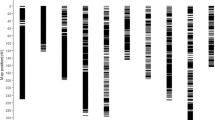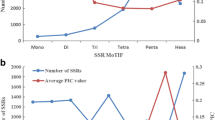Abstract
Mucuna pruriens is a well-recognized agricultural and horticultural crop with important medicinal use. However, antinutritional factors in seed and adverse morphological characters have negatively affected its cultivation. To elucidate the genetic control of agronomic traits, an intraspecific genetic linkage map of Indian M. pruriens has been developed based on amplified fragment length polymorphism (AFLP) markers using 200 F 2 progenies derived from a cross between wild and cultivated genotypes. The resulting linkage map comprised 129 AFLP markers dispersed over 13 linkage groups spanning a total distance of 618.88 cM with an average marker interval of 4.79 cM. For the first time, three QTLs explaining about 6.05–14.77% of the corresponding total phenotypic variation for three quantitative (seed) traits and, eight QTLs explaining about 25.96% of the corresponding total phenotypic variation for three qualitative traits have been detected on four linkage groups. The map presented here will pave a way for mapping of genes/QTLs for the important agronomic and horticultural traits contrasting between the parents used in this study.


Similar content being viewed by others
References
Ahmad N. S. 2012 Genetic analysis of plant morphology in Bambara groundnut (Vigna subterranea (L.) Verdc.). BSc Thesis. University of Nottingham, Nottinghanshire, UK.
Bairiganjan G. C. and Patnaik S. N. 1989 Chromosome evolution in Fabaceae. Cytologia 54, 51–64.
Brainerd E. 1924 Some natural violet hybrids of North America. Vermont Agr. Exp. Sta. Bull. No. 239.
Bressani R. 2002 Factors influencing nutritive value in food grain legumes: Mucunacompared to other grain legumes. In Food and feed from Mucuna: current uses and the way forward (ed. B. M. Flores, M. Eilitta, R. Myhrman, L. B. Carew and R. J. Carsky) pp. 164–188, Workshop, CIDICCO, CIEPCA and World Hunger Research Center, Tegucigalpa Honduras, USA.
Bonifácio E. M., Fonsêca A., Almeida C., Dos Santos K. G. B. and Pedrosa-Harand A. 2012 Comparative cytogenetic mapping between the lima bean (Phaseolus lunatus L.) and the common bean (P. vulgaris L.). Theor. Appl. Genet. 124, 1513–1520.
Buckles D. 1995 Velvetbean: a “new” plant with a history. Econ. Bot. 49, 13–25.
Capo-Chichi L. J. A., Weaver D. B. and Morton C. M. 2001 AFLP assessment of genetic variability among Velvetbean (Mucuna sp.) accessions. Theor. Appl. Genet. 103, 1180–1188.
Capo-Chichi L. J. A., Weaver D. B. and Morton C. M. 2004 An intraspecific genetic map of velvetbean (Mucuna sp.) based on AFLP markers. Theor. Appl. Genet. 108, 814–821.
Carsky R. J. and Ndikawa R. 1998 Identification of cover crops for the semi-arid savanna zone of west Africa. In Cover crops in west Africa—contributing to sustainable agriculture (ed. D. Buckles, A. Eteka, M. Osiname, M. Galiba and G. Galiano) pp. 179–187, IDRC, IITA, Sasakawa Global 2000, Otawa, Canada, Ibadan, Nigeria, Cotonou, Benin.
Darlington C. D. and Mather K. 1949 The elements of genetics. Allen & Unwin, London, UK.
Doyle J. J. and Doyle J. 1990 Isolation of DNA from plant tissue. Focus 12, 13–15.
Eilittä M., Bressani R., Carew L. B., Carsky R. J., Flores M., Gilbert R. et al. 2002 Mucuna as a food and feed crop: an overview. In Food and feed from Mucuna: current uses and the way forward, (ed. B. M. Flores, M. Eilittä, R. Myhrman, L. B. Carew and R. J. Carsky) pp 18–47, workshop CIDICCO, CIEPCA and World Hunger Research Center, Tegucigalpa, Honduras USA.
Fang X., Wu W. and Tang J. 2000 DNA marker-assisted breeding in crops. Scientific Press, Beijing, China.
Fujii Y., Shibuya T. and Yasuda T. 1991 L-3,4-dihydroxyphenylalanine as an allelochemical candidate from Mucuna pruriens (L.) DC. var. utilis. Agric. Biol. Chem. 55, 617–618.
Haldane J. B. S. 1919 The combination of linkage values and the calculation of distances between the loci of linked factors. J. Genet. 8, 299–309.
Han O. K., Kaga A., Isemura T., Wang X. W., Tomooka N. and Vaughan D. A. 2005 A genetic linkage map for azuki bean (Vigna angularis (Wild.) Ohwi & Ohashi). Theor. Appl. Genet. 111, 1278–1287.
Haq N. 1983 New food legume crops for the tropics, In Better crops for the food (ed. J. Nugent and M. O. Cormor) pp. 144–160. Pitman Books, London (Cuba Foundation Symposium, 97), UK.
Hayashi M., Miyahara A., Sato S., Kato T., Yoshikawa M., Taketa M. et al. 2001 Construction of a genetic linkage map of the model legume Lotus japonicus using an intraspecific F 2 population. DNA Res. 8, 301–310.
Iwata H. and Ninomiya S. 2004 Ant colony optimization for linkage grouping and locus ordering in genome mapping. Plant and Animal Genome XII, SanDiego, USA.
Jorge M. A., Eilitta M., Proud F. J., Maasdorp B. V., Beksissa H., Sarial A. K. and Hanson 2007 Mucuna species: recent advances in application of biotechnology. Fruit Veg. Cer. Sci. Biotech. 2, 80–94.
Julier B., Flajoulot S., Barre P., Cardinet G., Santoni S., Huguet T. and Huyghe H. 2003 Construction of two genetic linkage maps in cultivated tetraploid alfalfa (Medicago sativa) using microsatellite and AFLP markers. BMC Plant Biol. 3, 9.
Kavitha C. and Thangamani C. 2014 Amazing bean “Mucuna pruriens”—a comprehensive review. J. Med. Plants Res. 8, 138–143.
Kongjaimun A., Kaga A., Tomooka N., Somta P., Shimizu T., Shu Y. et al. 2012 An SSR-based linkage map of yardlong bean (Vigna unguiculata (L.) Walp. sub-sp. unguiculata Sesquipedalis group) and QTL analysis of pod length. Genome 55, 81–92.
Kosambi D. D. 1944 The estimation of map distances from recombination values. Ann. Eugen. 12, 172–175.
Lander E. S., Green P., Abrahamson J., Barlow A., Daly M. J., Lincoln S. E. and Newburg L. 1987 MAPMAKER: an interactive computer package of constructing primary genetic linkage maps of experimental and natural populations. Genomics 1, 174–181.
Leelambika M., Mahesh S., Jaheer M. and Sathyanarayana N. 2010 Comparative evaluation of genetic diversity among Indian Mucuna species using morphometric, biochemical and molecular approaches. World J. Agric. Sci. 6, 568–578.
Lotsy J. P. 1916 Evolution by means of hybridization. Martinees Nijhoff, The Hague, The Netherlands.
Padmesh P., Reji J. V., Jinish Dhar M. and Seeni D. 2006 Estimation of genetic diversity in varieties of M. pruriens using RAPD. Biol. Plant. 50, 367–372.
Plomion C., O’Malley D. M. and Durel C. E. 1995 Genomic analysis in maritime pine (Pinus pinaster): comparison of two RAPD maps using selfed and open-pollinated seeds of the same individual. Theor. Appl. Genet. 90, 1028–1034.
Sastrapradja S., Sastrapradja D., Aminah S. H., Lubis I. and Idris S. 1972 Comparative seedling morphology of Mucuna pruriens group. Ann. Bogoriendes. 5, 131–136.
Sastry C. S. T. and Kavathekar Y. Y. 1990 Plants for reclamation of wastelands. Publications and Information Directorate, New Delhi, India.
Sathyanarayana N., Vikas P. B., Bharath Kumar T. N. and Rajesha R. 2010 RAPD markers for genetic characterization of Mucuna species. Ind. J. Genet. 70, 296–298.
Sathyanarayana N., Leelambika M., Mahesh S. and Jaheer M. 2011 AFLP assessment of genetic diversity among Indian Mucuna accessions. Physiol. Mol. Biol. Plants 17, 171–180.
Sathyanarayana N., Mahesh S., Jaheer M. and Leelambika M. 2012 Genetic diversity of wild and cultivated M. pruriens (L.). DC accessions analyzed using thirty morpho-agronomical characters. Trop. Subtrop. Agroecosyst. 15, 249–259.
Siddhuraju P., Becker K. and Makkar H. P. 2000 Studies on the nutritional composition and antinutritional factors of three different germplasm seed materials of an under-utilized tropical legume, Mucuna pruriens var. utilis. J. Agric. Food Chem. 48, 6048–6060.
Staub J. E., Serquen F. C. and Gupta M. 1996 Genetic markers, map construction, and their application in plant breeding. Hort. Sci. 31, 729–740.
Szabo N. J. and Tebbett I. R. 2002 The chemistry and toxicity of Mucuna species. In Food and feed from Mucuna: current uses and the way forward (ed. M. Flores, M. Eilittä, R. Myhrman, L. B. Carew, R. J. Carsky) pp. 120–141. Proceedings of an International Workshop, CIDICCO, CIEPCA, World Hunger Research Center, Tegucigalpa, Honduras, USA.
Sun X., Yang T., Hao J., Xiaoyan Z., Ford R., Jiang J. et al. 2014 SSR genetic linkage map construction of pea (Pisum sativum L.) based on Chinese native varieties. Crop J., 170–174.
Tarawali G., Manyong V. M., Carsky R. J., Vissoh P. V., Osei-Bonsu P. and Galiba M. 1999 Adoption of improved fallows in west Africa: lessons from Mucuna and Stylo case studies. Agroforestry Syst. 47, 93–122.
Thoquet P., Ghérardi M., Journet E. -P., Kereszt A., Ané J. -M., Prosperi J. -M. and Hugust T. 2002 The molecular genetic linkage map of the model legume Medicago truncatula: an essential tool for comparative legume genomics and the isolation of agronomically important genes. BMC Plant Biol. 2, 1.
Vega U. and Frey K. J. 1980 Transgressive segregation in inter and intraspecific crosses of barley. Euphytica 2, 585–594.
Voorrips R. E. 2002 MapChart: software for the graphical presentation of linkage maps and QTLs. J. Hered. 93, 77–78.
Wang S., Basten C. J. and Zeng Z. B. 2012 Windows QTL Cartographer 2.5. Department of Statistics, North Carolina State University, Raleigh, NC (http://statgen.ncsu.edu/qtlcart/WQTLCart.htm).
Xu Y. and Zhu L. 1994 Molecular quantitative genetics. Chinese Agricultural Press, Beijing, China.
Yuste-Lisbona F. J., Santalla M., Capel C., García-Alcázar M., De La Fuente M., Capel J. et al. 2012 Marker-based linkage map of Andean common bean (Phaseolus vulgaris L.) and mapping of QTLs underlying popping ability traits. BMC Plant Biol. 12, 136.
Acknowledgements
The authors acknowledge financial support from the Department of Science and Technology (DST) and Department of Biotechnology (DBT), Govt. of India for this project. NS thank Sikkim University, Gangtok and Sri Krishnadevaraya Educational Trust (Sri KET), Bangalore, India for the laboratory and field facilities.
Author information
Authors and Affiliations
Corresponding author
Additional information
[Mahesh S., Leelambika M., Jaheer M., Anithakumari A. M. and Sathyanarayana N. 2016 Genetic mapping and QTL analysis of agronomic traits in Indian Mucuna pruriens using an intraspecific F2 population. J. Genet. 95, xx–xx]
MS and LM raised mapping population, carried out marker analysis and QTL mapping. MJ assisted in field and laboratory works. AAM reviewed the manuscript. NS conceptualized the work and obtained funding
Rights and permissions
About this article
Cite this article
MAHESH, S., LEELAMBIKA, M., JAHEER, M. et al. Genetic mapping and QTL analysis of agronomic traits in Indian Mucuna pruriens using an intraspecific F2 population. J Genet 95, 35–44 (2016). https://doi.org/10.1007/s12041-015-0602-1
Received:
Revised:
Accepted:
Published:
Issue Date:
DOI: https://doi.org/10.1007/s12041-015-0602-1




